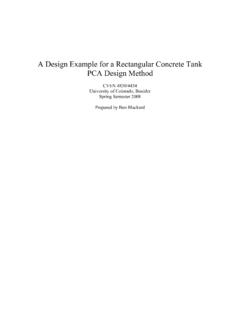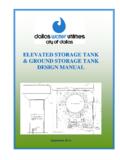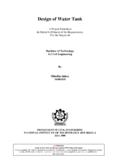Transcription of Rainwater tank desing and installation handbook Nov 08
1 MPMSAA Rainwater Tank design and installation handbook 2008 Rainwater Tank design and installation handbook November 2008 2 MPMSAA Rainwater T ank design and installation handbook 2008 PREFACE The objective of this handbook is to provide practical information for the collection, storage and use of Rainwater within private, multi-unit, community and commercial properties for the uses specified. It draws extensively on information from state, territory and national guidelines and standards across Australia (Section 21 Appendix), for the management and use of Rainwater to provide technical solutions that meet these guidelines and standards. This handbook has been developed to provide practical information for the collection, storage and use of Rainwater within private, community and commercial properties for the uses specified (excluding Rainwater used in industrial processes).
2 The handbook forms 1 component of a three-part package including: (a) This Rainwater Tank design and installation handbook (this document), which provides practical and technical information for plumbers to gain approval, install and maintain Rainwater systems for single households, multi-unit dwelling, community and commercial buildings; (b) The Greywater handbook , which provides practical and technical information for plumbers to gain approval, install and maintain greywater systems for single households; and (c) The National Water Commission Waterlines publication, which provides an initial overview of necessary information for communities to understand before pursuing the installation of greywater or Rainwater reuse devises in the domestic settings.
3 Together this package aims to progress urban water reform under the commitments outlined in the National Water Initiative (NWI), including innovation in water supply, encourage reuse and recycling and increase the efficient use of water within domestic settings. To optimise the full potential of Rainwater as an alternative water resource it is recommended that the Rainwater system be connected to internal plumbing connections ( , toilet, washing machine). This edition of the handbook was developed by the Australian Rainwater Industry Development Association (ARID) & the Master Plumbers and Mechanical Services Association of Australia (MPMSAA), with funding from the National Water Commission (NWC). Additional editorial and technical services were provided by Arris Pty Ltd (Dr Daryl Stevens).
4 The Rainwater Tank design and installation handbook was developed by ARID to assist responsible regulatory authority, plumbers, builders/developers and homeowners. It outlines the minimum standards and performance criteria for all development works associated with Rainwater tank installations within private and commercial properties. It applies to new Rainwater tank installations as well as alterations, additions, maintenance and repairs to existing installations. ARID was established in 2004 by the Master Plumbers & Mechanical Services Association of Australia in response to the Rainwater industry s concern that there was no national body representing the installation issues of Rainwater tanks. ARID s goal is to develop nationally consistent Rainwater and plumbing technologies and installation recommendations.
5 3 MPMSAA Rainwater T ank design and installation handbook 2008 This second edition of the handbook was developed to keep pace with emerging technology and the increased applications of Rainwater use in an urban environment, and is intended to be consistent with the various regulations and requirements; however, installers are advised to check with the plumbing authority regarding local conditions and requirements. Further information: The National Water Initiative (NWI) is the blueprint for improving Australia s water management and use. Under the NWI all Australian Governments have committed to encouraging innovation in water supply, encourage reuse and recycling and increasing the efficient use of water within domestic settings with the aim of creating Water Sensitive Cities.
6 4 MPMSAA Rainwater T ank design and installation handbook 2008 CONTENTS Page CHAPTER 1 PERFORMANCE 7 CHAPTER 2 PERFORMANCE GENERAL .. 9 Rainwater SUPPLY INSTALLATIONS .. 9 Rainwater TANK installation APPROVALS .. 10 Rainwater DETENTION .. 10 BUSHFIRE Rainwater STORAGE REQUIREMENTS .. 11 COMMUNITY/COMMERCIAL BUILDINGS .. 11 CHAPTER 3 Rainwater USE GENERAL USES OF Rainwater .. 13 PLUMBING APPLIANCES USING Rainwater .. 14 LOCAL/STATE GOVERNMENT WATER RESTRICTIONS .. 14 CHAPTER 4 OCCUPATIONAL HEALTH AND SAFETY GENERAL .. 15 LIFTING OF TANKS .. 15 TRENCH AND EXCAVATIONS .. 15 CONFINED SPACES .. 15 WORKING AT HEIGHTS .. 15 SITE ASSESSMENT .. 16 MAINTENANCE AND SERVICE .. 16 CHAPTER 5 design AND installation REQUIREMENTS AMENITY.
7 17 17 Rainwater TANK SETBACK 17 AUTHORISATION MATERIALS AND PRODUCTS .. 17 Rainwater TANK SIZING .. 19 Rainwater TANK OPENINGS .. 20 ABOVE-GROUND TANKS/TANK STANDS .. 21 GRAVITY FEED Rainwater SYSTEMS .. 21 STORMWATER PIPES AND FITTINGS .. 22 Rainwater SERVICE PIPE FROM Rainwater TANK .. 23 Rainwater TANK CONNECTION DEVICES IN CONTACT WITH THE NETWORK UTILITY DRINKING WATER .. 24 Rainwater TANK CONNECTED TO SINGLE SOURCE PUMP .. 24 FLEXIBLE Rainwater TANKS .. 25 ON-GROUND, IN-SLAB Rainwater STORAGE TANKS .. 25 underground Rainwater TANKS .. 25 HYDROSTATIC LIFT BALLAST CALCULATIONS .. 26 5 MPMSAA Rainwater T ank design and installation handbook 2008 CHAPTER 6 PRESSURE AND PUMPS GENERAL .. 28 PUMP SELECTION CRITERIA.
8 28 PUMP 28 PUMP PROJECTION installation .. 29 PUMP PERFORMANCE .. 30 MINIMUM AND MAXIMUM FLOW RATES AND PRESSURE REQUIREMENTS .. 30 CHAPTER 7 Rainwater MARKING AND LABELLING GENERAL .. 32 PIPE MARKINGS .. 32 IRRIGATION PIPE .. 32 EXTERNAL TAP SIGNAGE .. 33 CHAPTER 8 BACKFLOW PREVENTION GENERAL .. 34 NETWORK UTILITY OPERATOR S WATER SUPPLY TANK TOP-UP REQUIREMENTS .. 36 CHAPTER 9 MANAGEMENT OF Rainwater QUALITY GENERAL .. 38 MINIMISING CONTAMINATION .. 38 PRE-STORAGE TREATMENT DEVICES .. 43 VERMIN AND INSECT-PROOF SCREEN .. 43 Rainwater FILTRATION .. 45 Rainwater TREATMENT .. 48 CHAPTER 10 MONITORING AND MAINTENANCE GENERAL .. 50 CHAPTER 11 REBATES AND BUILDING RECOMMENDATIONS REBATES FOR Rainwater PRODUCTS AND INSTALLATIONS.
9 53 BUILDING REQUIREMENTS FOR Rainwater SYSTEMS .. 54 CHAPTER 12 RAINFALL DATA .. 56 CHAPTER 13 CALCULATING EXPECTED ANNUAL Rainwater CATCHMENT GENERAL .. 61 61 Rainwater COLLECTION CALCULATIONS .. 62 CHAPTER 14 AVERAGE WATER CONSUMPTION VALUES FOR URBAN ACTIVITIES GENERAL .. 64 6 MPMSAA Rainwater T ank design and installation handbook 2008 CHAPTER 15 ACCEPTABLE Rainwater INSTALLATIONS TECHNICAL DRAWINGS GENERAL .. 71 ABOVE-GROUND Rainwater TANK installation .. 71 UNDER-GROUND Rainwater TANK installation .. 82 UNDER FLOOR Rainwater TANK 86 CHAPTER 16 END USER Rainwater TANK 88 CHAPTER 17 ABBREVIATIONS .. 91 CHAPTER 18 GLOSSARY OF TERMS .. 93 CHAPTER 19 REFERENCES .. 109 Page APPENDICES A Rainwater RELATED GUIDELINES .. 110 7 MPMSAA Rainwater T ank design and installation handbook 2008 MPMSAA Error!
10 No text of specified style in document. C H A P T E R 1 P E R F O R M A N C E O B J E C T I V E S Rainwater (run-off due to rainfall on roofed areas) is recognised in Australia as an important water resource. The objectives of this handbook are to: (a) Encourage the adoption of Rainwater systems and better use of Rainwater across Australia. (b) Create an alternative water resource. (c) Provide plumbers with up-to-date technical details for the practical installation of Rainwater systems, including detailed diagrams of: (i) pre- and post-storage filters; (ii) plumbing requirements for the connection of Rainwater within the household; (iii) common uses of Rainwater across Australia; (iv) new technology bladder tanks, plastic cell structures, underground tanks, Rainwater treatment, constant filtrations; (v) expanding the use of Rainwater for additional uses (hot water, cooling towers); and (vi) installation approval processes.









